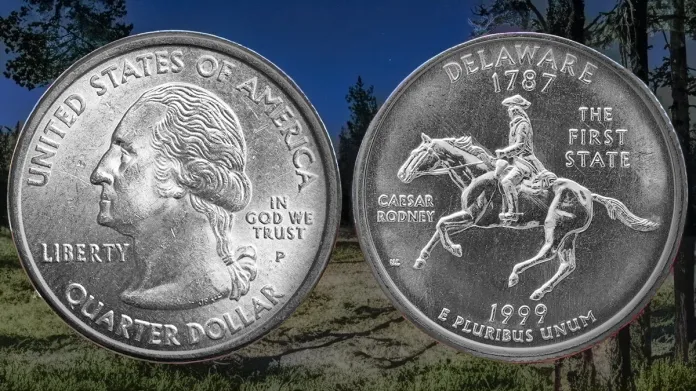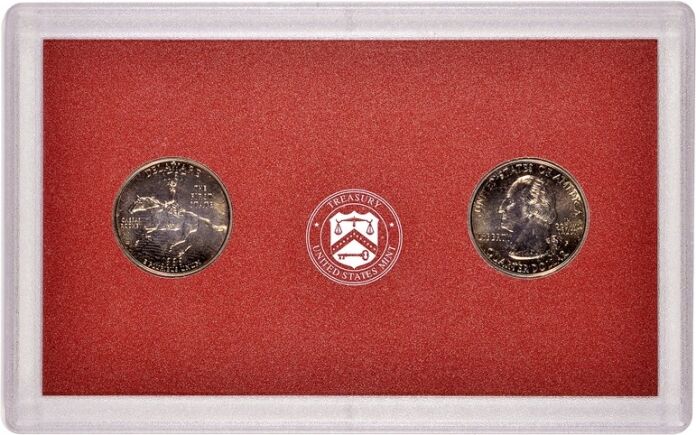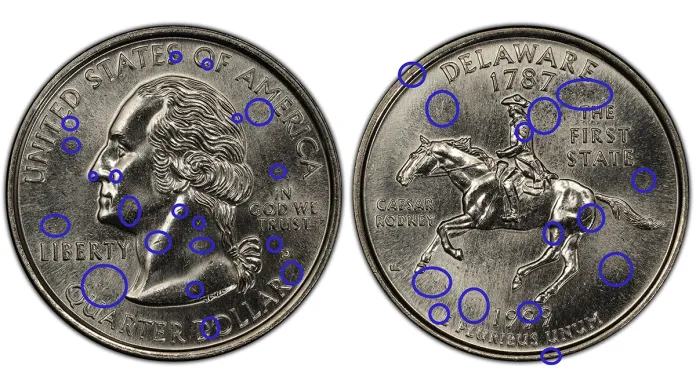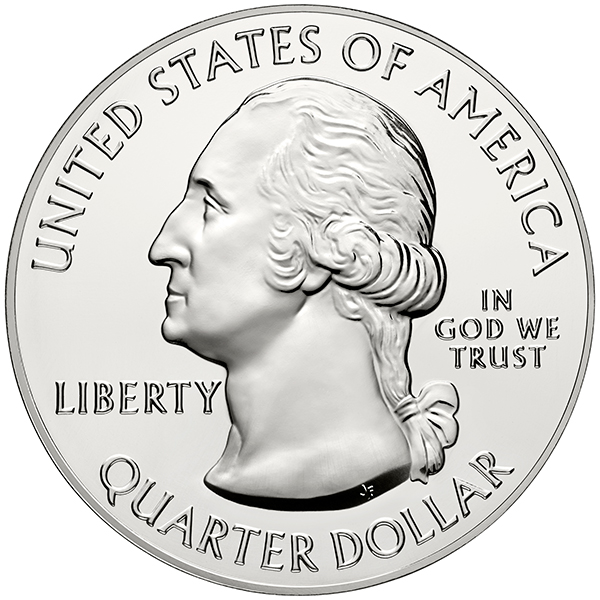
By Charles Morgan and Hubert Walker for CoinWeek Notes ….
The 1999 Delaware Quarter, released on January 1, was the first issue in the 50 State Quarters series (Public Law 105-124 – PDF link) and honors the first state to ratify the United States Constitution on December 7, 1787. The reverse features Founding Father Caesar Rodney, who served as a militia officer during the Revolutionary War and was a member of the Continental Congress. Upon receiving word in Dover that key votes on the call for independence were deadlocked on July 1, 1776, a determined Rodney jumped on his horse and galloped 70 miles north to Philadelphia, arriving just as voting got underway on July 2. He signed the Declaration of Independence on August 2.
The “Quartergate” Controversy
On February 2, 1998, Delaware Governor Tom R. Carper (D) held a statewide competition to come up with design finalists for what would be the first circulating United States quarter commemorative since the Bicentennial.
Of the approximately 300 entries, 40 came from Caesar Rodney High School and the art class of Eddy Seger. Among the submitted designs was one executed by Seger himself, which featured a right-facing Caesar Rodney riding a galloping horse. Behind Rodney was the outline of the shape of the state of Delaware, vegetal ornamentation wrapped around the rim. The inscriptions UNITED STATES of AMERICA and E PLURIBUS UNUM remained unchanged from the Washington Quarter Heraldic Eagle reverse in Seger’s concept; the format of the 50 State Quarters obverse and reverse had not been made public at this time.
The final design would mirror Seger’s work and improve upon it. The vegetal wreaths and the state’s outline were eliminated, and the equestrian Rodney would face left instead of right, his horse elongated, his figure more sinewy and upright. Mint Engraver William Cousins, who adapted Seger’s concept for coining, is credited as the Delaware State Quarter’s designer; his initials “WC” feature to the left of the horse’s lead hoof.
Initially, the United States Mint gave Seger credit for submitting the winning design but has since scrubbed any reference to him on their website. More recently it has been alleged that Seger’s design was one of several submitted that featured Caesar Rodney. But this claim is dubious and was likely put forward in an effort by the Government to take design credit away from state artists.
Controversy surrounding multiple State Quarter designs erupted publicly in 2002 when the national and numismatic media brought artists’ complaints surrounding design attribution to the public’s attention. The dustup is known as “Quartergate”.
For their part, third-party grading service PCGS promoted Seger’s involvement in the coin’s design by producing a limited-edition insert label featuring his autograph.
Coin Launch Ceremony and Special Holder

A special launch ceremony was held on December 7, 1998, at the Philadelphia Mint, during which the first 50 State Quarters were struck. VIPs in attendance were presented with two examples of the coin secured in a special plastic U.S. Mint holder. These holders were unknown to hobbyists until an example surfaced in 2019. The coins in that set were removed from the holder, conserved by NGC, and individually encapsulated with a special pedigree.
The Single PCGS MS69 Doesn’t Look Like a 69 to Us

Generally, we trust an experienced grader with a coin in hand over someone who only has a photograph to go on, but in the case of the Top Pop, Pop 1 1999-P Delaware State Quarter graded MS69 by PCGS, we feel that an exception can be made. While this coin may have booming luster and a great look in hand, the fact remains that the coin has more than a dozen incidental contact marks, with some in focal areas. Were this an American Silver Eagle, we doubt a coin with this many ticks would grade MS69, and given the fact that this coin would likely command a price 10 times more than an MS68, we think the coin deserves the extra scrutiny.
* * *
Market Data and Noteworthy Specimens
The 50 State Quarters Program kicked off on January 4, 1999. That evening, TV coin shows offered Brilliant Uncirculated (BU) rolls of P- and D-Mint quarters for several times face value. Within weeks, the new quarters were readily available to the general public at face value.
For collectors and dealers looking uncirculated business strike examples in volume, the Mint opened sales of 100- and 1,000-coin bags of the 1999-P Delaware Quarter on May 14, 1999; initial retail prices were $29.95 and $289.95, respectively.
The 1999 Silver Proof Set, which includes the first five State Quarters, was highly sought after by collectors immediately following its release. By 2002, the set was trading for more than $150; at the time of publication in June 2024, the raw set trades for about $50-$60.
Top Population: PCGS MS69 (1, 4/2025), NGC MS68 (58, 4/2025), and CAC N/A (4/2025).
- PCGS MS68PL #21869735: Heritage, December 4, 2007 – $1,472. Michael Fuller Collection pedigree.
- NGC MS68PL #2155481-023: Heritage, December 27, 2016 – $152.75.
- PCGS MS68 #14840317: Heritage, December 13, 2018 – $960.
- NGC MS68 #1987538-002: Heritage, April 20, 2008 – $253.
- NGC MS68 #1216970-001: GreatCollections, November 11, 2012 – View.
- NGC MS68 #3101437-022: Heritage, January 12, 2013 – $129.25.
- NGC MS68 #2563516-008: Heritage, May 10, 2015 – $94.
- NGC MS68 #2208454-004: Heritage, December 25, 2016 – $61.
* * *
Design

Obverse:
The obverse of the 1999 Delaware Quarter is the first to show a modified portrait of President George Washington, a design by John Flanagan based on a 1786 plaster bust by French sculptor Jean-Antoine Houdon. Sculptor-engraver William Cousins designed the newer rendition of Washington.
The redesign was necessary, in part, to accommodate new inscriptions on the obverse that previously were featured on the reverse of the quarter; these obverse inscriptions on the 1999 Delaware Quarter include the legend UNITED STATES OF AMERICA in a semi-circular arrangement over Washington’s head, the motto IN GOD WE TRUST to his right, LIBERTY below his chin to his left, and the denomination QUARTER DOLLAR along the bottom side of the rim, under the first president’s bust. The words “QUARTER DOLLAR” and “UNITED STATES OF AMERICA” were previously located on the reverse of Washington Quarters made from 1932 through 1998 but were relocated to the obverse to allow a wider reverse canvas area for the changing 50 States Quarter designs. The P mintmark is seen to the right of Washington’s ponytail, below IN GOD WE TRUST.
Reverse:
Caesar Rodney is seen riding his horse on the reverse of the 1999 Delaware Quarter. The design captures the nighttime ride Rodney made during a thunderstorm from Dover to Philadelphia to cast a deciding vote for independence. The inscription DELAWARE and the date 1999 are seen above Rodney; above the trailing tail of the galloping horse are the words THE FIRST STATE, a nickname in which Delaware takes great pride. To the left of the horse is the inscription CAESAR RODNEY. Below are the initials of engraver William Cousins.
Edge:
The edge of the 1999 Delaware 50 State Quarter is reeded, as are the edges of all Washington Quarters.
Designers
American sculptor John Flanagan’s work in the medallic and metal arts ranks him as one of the best artists of his generation. For generations of coin collectors, he is best known for his Washington quarter design (View Designer’s Profile).
William Cousins was a sculptor-engraver at the United States Mint. He retired in 2000.
Coin Specifications
| Country: | United States of America |
| Year of Issue: | 1999 |
| Denomination: | Quarter Dollar (25 Cents USD) |
| Mintmark: | P (Philadelphia) |
| Mintage: | 373,400,000 |
| Alloy: | .750 copper, .250 nickel |
| Weight: | 5.67 g |
| Diameter: | 24.30 mm |
| Edge: | Reeded |
| OBV Designer: | John Flanagan | William Cousins |
| REV Designer: | William Cousins |
| Quality: | Business Strike |
* * *


